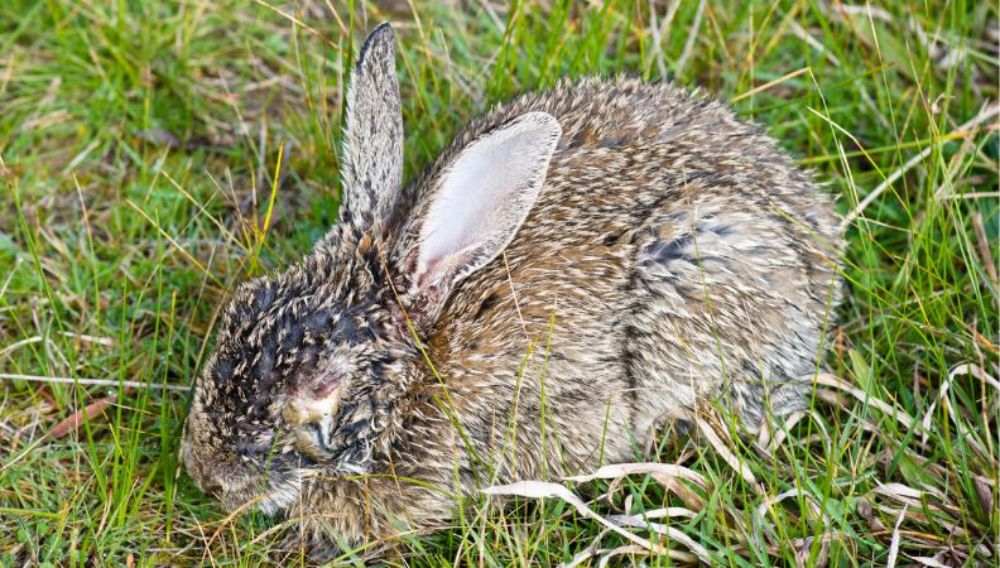
Myxomatosis is an extremely infectious disease that was identified in the 1930s as being caused by the myxoma virus. The virus was used as a biological weapon in the 1950s to control the wild rabbit populations in Australia and France.
The disease arrived in the United Kingdom in 1953 and since then, both the wild and domestic rabbit populations have been affected. All pet rabbits are at risk, even indoor rabbits but especially those that live outside.
With the help of Vet Experts, Vetstream, we've put together this guide so all rabbit owners know the steps they can take to prevent their rabbit catching the disease and how to spot the early symptoms of myxomatosis.
What is Myxomatosis?
Myxomatosis is a highly contagious disease caused by the myxoma virus. This virus is spread by biting flies or fleas (such as the rabbit flea Spilopsyllus cuniculi). It is also spread by vectors such as non-biting fleas, bedding and food. Myxy (or myxyo) has a higher seasonal prevalence in late summer, autumn and early winter and is widespread throughout the UK.
The biting insect introduces the virus into the blood stream and signs of the disease usually show within 8 days of transmission. Illness lasts between 11-18 days with death occurring within 14 days of infection in the acute form.
How to Help Prevent Myxomatosis
Myxomatosis can be prevented by vaccination and vector control (limiting the fleas and biting flies that can transmit the virus).
A combined vaccination for myxomatosis and rabbit haemorrhagic disease 1 and rabbit haemorrhagic disease 2 (RHD1 and RHD2) is available in the UK. Vaccinated rabbits will be immune within 3 weeks of vaccination and have a duration of immunity of 1 year. This means that annual boosters are required. Vaccination can be given at 5 weeks of age and is best given in May or June before the peak myxomatosis season.
Vector control aims to reduce the risk of your rabbit being bitten by fleas or flies that can carry the virus. Myxomatosis is very common in wild rabbits so place your rabbit hutch as far away as possible from wild rabbits and try to keep wild rabbits out of your garden. Disinfecting the hutch and making sure all rabbit bowls, bottles, etc. are rinsed and dry before use is also advised.
Insect repellent strips and mosquito nets above the hutch are good preventative measures in high-risk areas, as well as removing all sources of stagnant water that can attract mosquitoes. Pet rabbits should also be treated regularly with a flea treatment and, as cat and dog fleas can also harbour the virus, any other pets should be treated for fleas as well.
Warning Symptoms of Myxomatosis in Rabbits

The symptoms of myxomatosis to watch out for are swelling of the lips, eyelids and genitals. Infected rabbits may also have a high temperature, be depressed, have laboured breathing and skin nodules.
Rabbit myxomatosis is seen in two forms: acute (sudden onset) and chronic (long-term). The symptoms of acute infection are:
- Swelling around lips, eyelids and genitals
- Ocular discharge
- Lethargy, temperature and blindness
- Nose swelling which can lead to suffocation (rabbits are nose-breathers) and nasal discharge
- Secondary lung infection and death
The symptoms of chronic infection are:
- Skin swellings, known as myxomas or pseudotumours, develop after 10-15 days, mainly on ears, nose and paws
- The swellings disappear, healing to leave scabs
- 50% of rabbits can recover from this chronic form with treatment
If your pet rabbit is showing any of the above signs, contact your vet for advice.
Can My Rabbit be Treated for Myxomatosis?
Wild myxy rabbits tend to die as blindness and debility make them easy targets for foxes and road accidents. Pet rabbits tend to live longer with good nursing care although they are usually put to sleep to avoid unnecessary suffering. If treated in the early stages of the disease, affected rabbits can be given eye drops, antibiotics and gastrointestinal stimulants, along with hand or syringe feeding. However, euthanasia is advised if the signs of the disease are advanced, i.e. eyes are closed or rabbit has breathing difficulty.
50% of rabbits generally survive the chronic nodular form of the disease, but from the acute form the rabbit dies as they're unable to survive more than 2 weeks. Vaccinated rabbits show less severe signs of infection and may require many weeks or months of intensive nursing care.
What to do if Your Rabbit has Myxomatosis
Myxomatosis in rabbits can be prevented by vaccination and control of fleas and mosquitos/biting insects. However, vaccination does not guarantee absolute protection and annual boosters are required to maintain immunity. Vaccinated rabbits can still be infected, but they often survive and have a less severe disease.
If there has been an outbreak of myxyomatosis, all in-contact rabbits should be vaccinated and housing thoroughly disinfected (eg with 10% bleach - but check that the disinfectant is not harmful to rabbits). Also make sure your rabbit and other pets in your household have regular flea treatments.
Myxomatosis is a serious viral disease that is highly contagious and usually fatal. There is no cure so every step should be taken to prevent your rabbit being infected. Vaccination is essential along with annual boosters and flea treatment. If your rabbit has been vaccinated and catches myxomatosis, the chances are that the disease will be mild, and they’ll make a full recovery with intensive nursing care.
If you suspect your rabbit has myxomatosis, contact your vet as soon as possible.
Everypaw Rabbit Insurance
Here at Everypaw, we want to help you keep your bunny healthy and in tip top shape. So, when it comes to your young rabbit’s care, Everypaw’s Rabbit Insurance could be just the cover to look after your little thumper.
Content provided from Vetstream's Vetlexicon Lapis – www.vetlexicon.com/treat/lapis
Vetlexicon is the world’s largest peer-reviewed online clinical reference source. All our content is written and peer-reviewed by over 1,000 of the world’s leading veterinarians, ensuring relevance, accuracy and quality.
- Vetstream Ltd, Claire Speight (online) Myxomatosis - myxy. In: Vetlexicon Lapis. Vetstream Ltd, UK. Website: https://www.vetstream.com/treat/lapis/owner-factsheets/myxomatosis-myxy
- Aidan Rafferty, Susan Brown, Anna Meredith, Richard Saunders, Sarah Pellett (online) Myxomatosis. In: Vetlexicon Lapis. Vetstream Ltd, UK. Website: https://www.vetstream.com/treat/lapis/freeform/myxomatosis